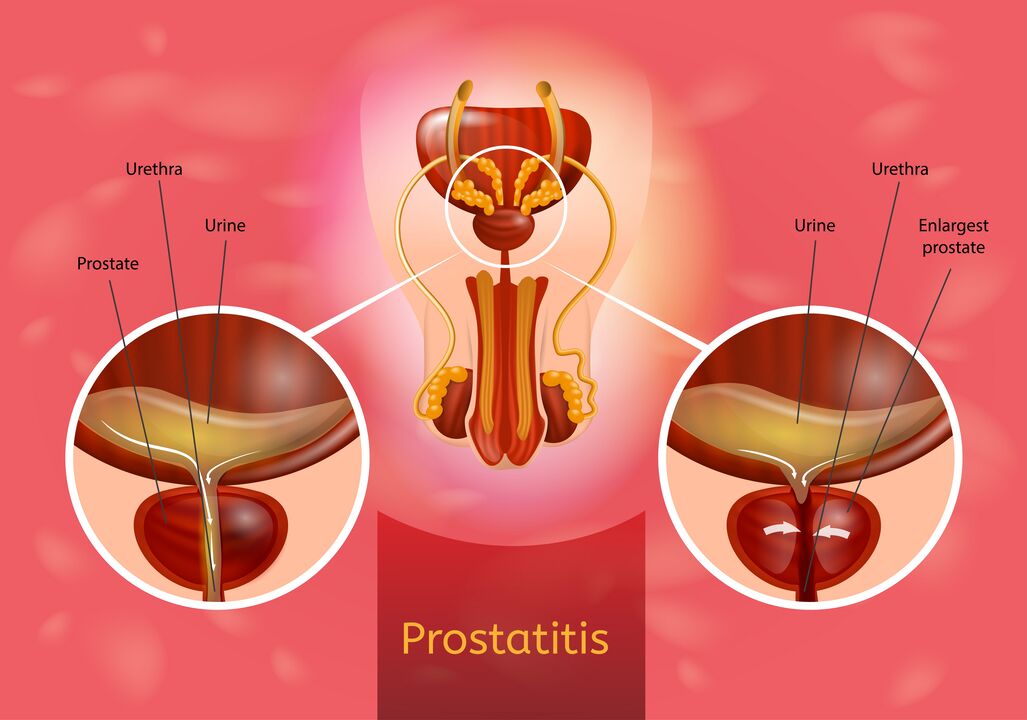Prostatitis is a disease of the prostate gland (prostate) that develops as a result of inflammatory changes in it.According to statistics, the spread of the disease reaches 35-50% and is detected in men aged 20-40 years.

Types
4 forms of prostatitis are distinguished:
- acute (bacterial);
- chronic bacterial;
- chronic non -bacterial;
- Asymptomatic chronic.
Acute prostatitis is very rare due to the rapid course of the inflammatory process and an immediate transition to the chronic stage (false improvement).
Chronic non -bacterial prostatitis, otherwise it is called chronic pelvic pain syndrome, may have inflammatory (with the presence in the urine and ejaculate of the high content of leukocytes), not inflammatory by nature.
Reasons
The cause of acute and chronic bacterial prostatitis is pathogenic microorganisms (viruses, bacteria, fungi).Most often the source of inflammation is:
- E. cars;
- streptococci;
- Staphylococci;
- Proteus;
- Klebsiella;
- Pseudomonal stick;
- Pathogens of sexually transmitted diseases (Chlamydia, Mycoplasmas, Gonococci, Trichomonas, Cytomegalovirus and others).
Most of the microorganisms are in the intestine, on the skin, but, entering the tissue of the prostate, they cause an inflammatory process.As a rule, the cause of the disease is not a pathogen, but an association of several types of germs.
The development of chronic prostatitis can cause the following factors:
- concomitant diseases of the urinary system (cystitis, pyelonephritis);
- sedentary lifestyle ("stuck" work);
- tendency to constipation;
- weakening of body protection;
- Injuries;
- hormonal imbalance;
- alcohol and smoking abuse;
- accidental sexual contact;
- irregular sex life (long -term abstinence);
- interrupted sexual contact;
- irregular emptying of the bladder;
- Unattached sexual desire;
- chronic loads;
- hypothermia;
- The presence of carious teeth and other sources of chronic infection (eg chronic tonsillitis).
Symptoms of prostatitis
Acute prostatitis is a very insidious disease.It is quite difficult to "catch" it, because first, the process becomes chronic very quickly and secondly, most patients prefer to "sink" manifestations of acute prostatitis of the house.Patients with prostate inflammation often seek the doctor in advanced cases with erection disorders and other consequences.
The acute form of the disease is on the background:
- fever;
- chills;
- Other signs of intoxication (weakness, lethargy, loss of appetite, etc.).
Prostate inflammation is accompanied by pain in the perineum, in the inguinal region and in the scrotum.
Painful and rapid urination is also characteristic.Sometimes in the urine you can notice a whitish purulent ejection.
In addition, the patient may pay attention to the lack of night and morning erection, poor quality erection during intimacy, and a sharp shortening of sexual contact.
Typical symptoms of urination disorders appear: a weak stream of urine and a frequent desire, although the urine itself stands out a little.
In the future, in the absence of treatment, chronic prostatitis reaches the apogues: there are disorders of sexual function.For example:
- insufficient erection or its absence;
- a painful erection that causes the patient to avoid sexual contact;
- Deleted orgasm;
- short intercourse;
- Ejaculation soreness.
Chronic abacus prostatitis is 95% of all prostatitis, they suffer mainly from men aged about 30 years.It is characterized by persistent or periodic pelvic pain, prostate, in the scrotum, while there are no signs of inflammation in laboratory analyzes.The causes of the disease are definitely not established.
Diagnostics
In the diagnosis of acute and chronic prostatitis, the following methods are used in addition to collecting complaints, history and examination of the patient:
- General blood and urine test;
- Microscopic examination of the secret of the prostate and the seed of the nutrient medium to detect the pathogen (the secret is obtained after massage of the finger of the prostate gland through the rectum);
- Cytological examination of urine;
- Prostate and pelvic ultrasound;
- Computed tomography and nuclear magnetic resonance (MRI);
- Spread from the microflora urethra.
The differential diagnosis is aimed at distinguishing between prostatitis, prostate adenoma, prostate cancer, signs of prostate stones.
A complete list of diagnostic procedures and medicines for the treatment of prostatitis in the federal standard of help since 2012.
Prostatitis
The same symptoms can be signs of various diseases and the disease may not occur according to the textbook.Do not try to treat yourself, consult a doctor.A surgeon-urologist leads to prostatitis.
The purpose of ethitropic treatment aimed at eliminating the cause of prostatitis is to eliminate the pathogen.Depending on the identified cause, antibiotics, antiviral or antifungal drugs are prescribed.The duration of therapy for acute prostatitis is 7-10 days, in the chronic process-4-8 weeks.
For the treatment of bacterial infection, they are used:
- antibiotics (ciprofloxacin, levofloxacin, moxifloxacin);
- macrolides (erythromycin, clarithromycin);
- doxycycline;
- Antibacterial drugs.
The antitrust (Diflucan, Fluconazole) are prescribed orally and in rectal candles.
In addition, other types of therapy are used:
- anti -allergic (Suprastin, Claritin, Dimedrol);
- anti -inflammatory (indomethacin, diclofenac);
- Anesthetic (No-Shpa, Analgin, Baralgin).
They are also appointed:
- physiotherapy;
- medical gymnastics;
- Prostate massage.
The whole course of treatment takes 3-4 months.
Prevention
The following conditions must be observed to prevent the disease:
- Regular sex life;
- rejection of bad habits;
- maintaining a healthy lifestyle (sports, walking in the fresh air);
- adherence to the diet;
- A regular visit to the urologist.























